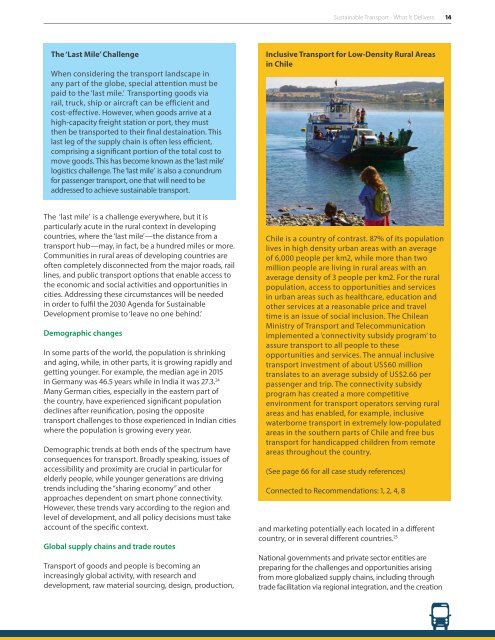MOBILIZING DEVELOPMENT
a5OQ306q56U
a5OQ306q56U
Create successful ePaper yourself
Turn your PDF publications into a flip-book with our unique Google optimized e-Paper software.
Sustainable Transport - What It Delivers 14<br />
The ‘Last Mile’ Challenge<br />
When considering the transport landscape in<br />
any part of the globe, special attention must be<br />
paid to the ‘last mile.’ Transporting goods via<br />
rail, truck, ship or aircraft can be efficient and<br />
cost-effective. However, when goods arrive at a<br />
high-capacity freight station or port, they must<br />
then be transported to their final destaination. This<br />
last leg of the supply chain is often less efficient,<br />
comprising a significant portion of the total cost to<br />
move goods. This has become known as the ‘last mile’<br />
logistics challenge. The ‘last mile’ is also a conundrum<br />
for passenger transport, one that will need to be<br />
addressed to achieve sustainable transport.<br />
Inclusive Transport for Low-Density Rural Areas<br />
in Chile<br />
The ‘last mile’ is a challenge everywhere, but it is<br />
particularly acute in the rural context in developing<br />
countries, where the ‘last mile’—the distance from a<br />
transport hub—may, in fact, be a hundred miles or more.<br />
Communities in rural areas of developing countries are<br />
often completely disconnected from the major roads, rail<br />
lines, and public transport options that enable access to<br />
the economic and social activities and opportunities in<br />
cities. Addressing these circumstances will be needed<br />
in order to fulfil the 2030 Agenda for Sustainable<br />
Development promise to ‘leave no one behind.’<br />
Demographic changes<br />
In some parts of the world, the population is shrinking<br />
and aging, while, in other parts, it is growing rapidly and<br />
getting younger. For example, the median age in 2015<br />
in Germany was 46.5 years while in India it was 27.3. 24<br />
Many German cities, especially in the eastern part of<br />
the country, have experienced significant population<br />
declines after reunification, posing the opposite<br />
transport challenges to those experienced in Indian cities<br />
where the population is growing every year.<br />
Demographic trends at both ends of the spectrum have<br />
consequences for transport. Broadly speaking, issues of<br />
accessibility and proximity are crucial in particular for<br />
elderly people, while younger generations are driving<br />
trends including the “sharing economy” and other<br />
approaches dependent on smart phone connectivity.<br />
However, these trends vary according to the region and<br />
level of development, and all policy decisions must take<br />
account of the specific context.<br />
Global supply chains and trade routes<br />
Transport of goods and people is becoming an<br />
increasingly global activity, with research and<br />
development, raw material sourcing, design, production,<br />
Chile is a country of contrast. 87% of its population<br />
lives in high density urban areas with an average<br />
of 6,000 people per km2, while more than two<br />
million people are living in rural areas with an<br />
average density of 3 people per km2. For the rural<br />
population, access to opportunities and services<br />
in urban areas such as healthcare, education and<br />
other services at a reasonable price and travel<br />
time is an issue of social inclusion. The Chilean<br />
Ministry of Transport and Telecommunication<br />
implemented a ‘connectivity subsidy program’ to<br />
assure transport to all people to these<br />
opportunities and services. The annual inclusive<br />
transport investment of about US$60 million<br />
translates to an average subsidy of US$2.66 per<br />
passenger and trip. The connectivity subsidy<br />
program has created a more competitive<br />
environment for transport operators serving rural<br />
areas and has enabled, for example, inclusive<br />
waterborne transport in extremely low-populated<br />
areas in the southern parts of Chile and free bus<br />
transport for handicapped children from remote<br />
areas throughout the country.<br />
(See page 66 for all case study references)<br />
Connected to Recommendations: 1, 2, 4, 8<br />
and marketing potentially each located in a different<br />
country, or in several different countries. 25<br />
National governments and private sector entities are<br />
preparing for the challenges and opportunities arising<br />
from more globalized supply chains, including through<br />
trade facilitation via regional integration, and the creation


